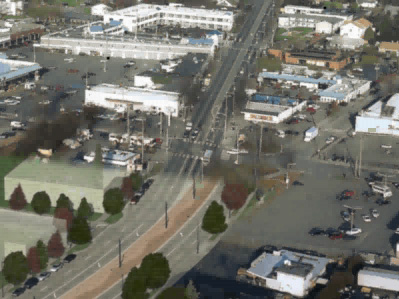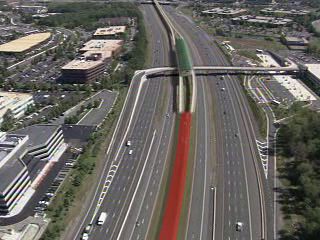Compositing / 2.5D Animation
2.5 D refers to visualizations that use a layer of animation over a static view where the base image doesn't change. These images are essentially photosimulations where one or more of the layers is animated. A good example would be a view of a road where the new road surfaces and the background are based on a static simulated view, but a few cars are moving in the scene. This approach can save valuable rendering time as the only elements that need be rendered for multiple frames are those things that move. The scene context and static new elements can be created in Photoshop as layers, and don't need to be modeled in great detail in 3D. If the view is created at high enough resolution, an animation can be created that zooms or pans within the overall view, thus adding to the realism and believability of the visualization, and the sense of three dimensionality in the view.

Download the visualization video (11MB file)
Compositing Programs
The two most commonly used applications used for compositing a mixture of static and animated layers are Adobe After Effects, and Autodesk Combustion (formerly a Discreet product). Both can be thought of as very similar to Photoshop but with the ability to use animation files as layers, and to animate a 'camera' view of the composite, allowing for pans and zooms within the view. Much like a photosimulation, there is a background layer, that can be a photo (or video sequence), middle layers that could include new roads and slopes, moving vehicles, and finally, a foreground layer with any elements between the viewer and the road. All of the static layers can be imported directly from original layered positions within a Photoshop image.
3D Camera Tracking

Download the 3D camera tracking video (2.9MB file)
The above animation is an example of a 3D model rendering composited over a moving video sequence, in this case footage shot from a helicopter. A specialized application is used that calculates the 3D path of the camera that shot the video directly from the sequence frame by frame. The process is similar to the camera match process, only each frame in the background has a unique camera position associated with it. The applications that perform this calculation are expensive, and the video footage must meet some certain criteria: the footage must be smooth, and only certain camera moves can be calculated from the footage.
